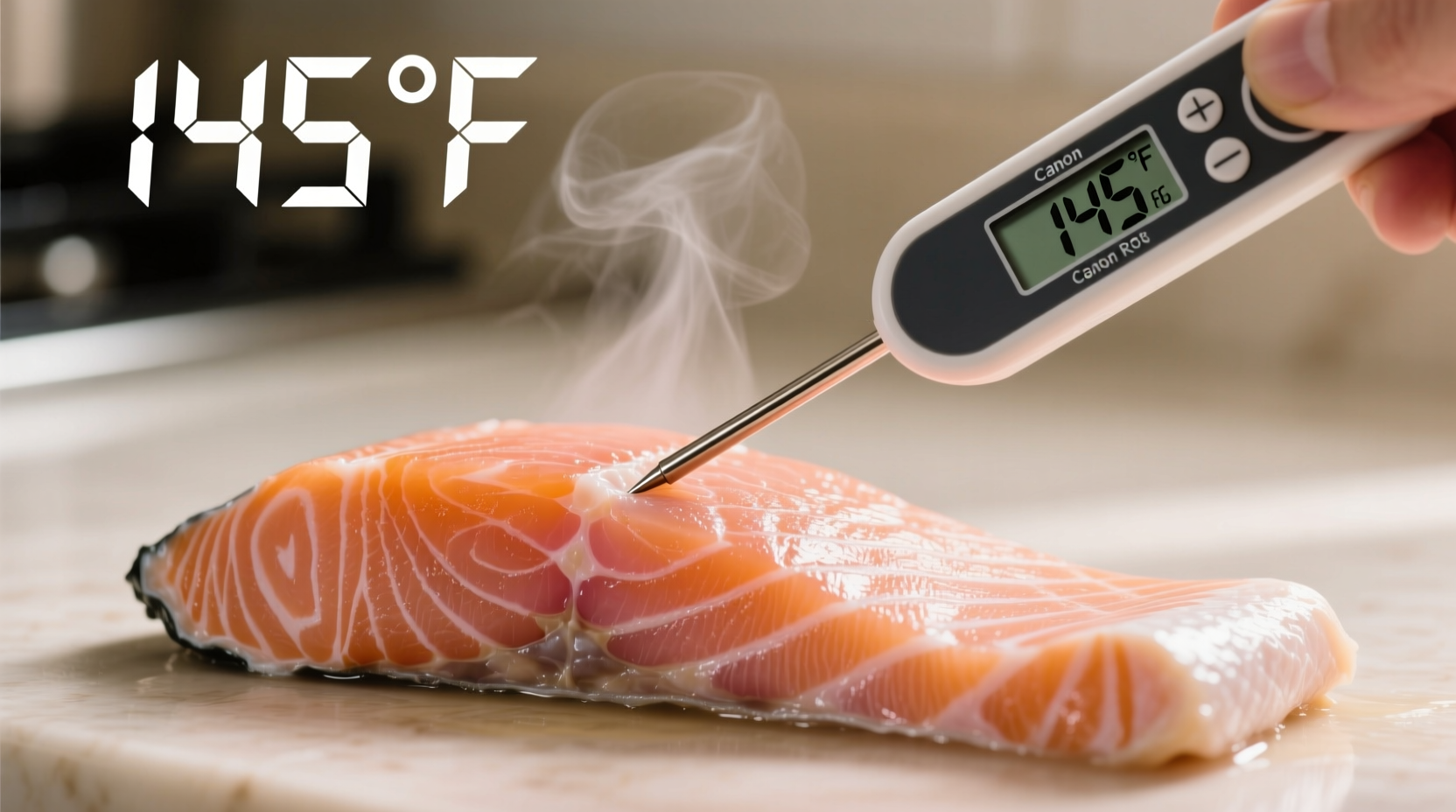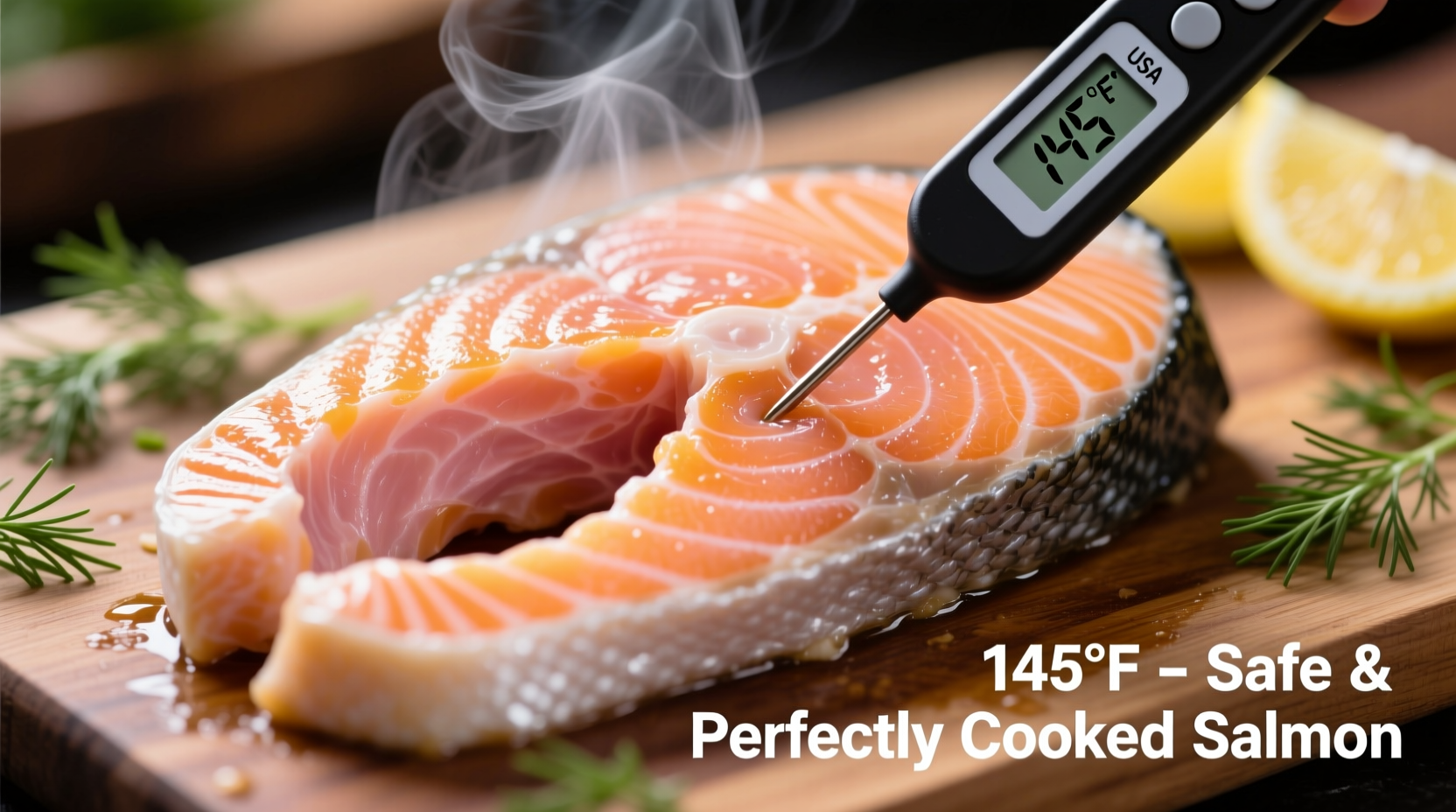Salmon reaches perfect doneness at an internal temperature of 125°F (52°C) for medium-rare to 145°F (63°C) for well-done, with the USDA's minimum safety recommendation at 145°F. This precise temperature range ensures food safety while preserving salmon's delicate texture and rich flavor profile.
Knowing exactly at what temperature is salmon cooked properly transforms your cooking results from dry and overcooked to moist and restaurant-quality. Whether you're a beginner home cook or an experienced chef, understanding the science behind salmon's ideal temperature prevents common mistakes that ruin this expensive fish.
The Science Behind Salmon Cooking Temperatures
Salmon's proteins begin denaturing at 104°F (40°C), with the critical transformation happening between 125°F-145°F (52°C-63°C). Unlike land animals, fish proteins coagulate quickly, making precise temperature control essential. The FDA Food Code specifies 145°F as the minimum safe temperature to eliminate potential pathogens like Listeria and Vibrio, though many culinary professionals recommend lower temperatures for optimal texture.
| Doneness Level | Internal Temperature | Visual Characteristics | Recommended For |
|---|---|---|---|
| Medium-Rare | 120°F-125°F (49°C-52°C) | Translucent center, flakes slightly | Sous vide, high-quality fresh salmon |
| Medium (Ideal) | 130°F-135°F (54°C-57°C) | Opaque but moist, separates easily | Most cooking methods, best texture |
| Medium-Well | 140°F (60°C) | Fully opaque, firm texture | Those preferring more cooked fish |
| Well-Done (USDA) | 145°F (63°C) | Dry, crumbly texture | Maximum food safety compliance |
Why Temperature Matters More Than Time
Unlike many cooking methods where timing is primary, salmon cooking temperature is the definitive indicator of doneness. Factors like fillet thickness, starting temperature, and cooking method dramatically affect cooking time. A 1-inch fillet might take 12 minutes at 400°F, while a 2-inch steak could require 20 minutes—but both reach perfect doneness at 130°F-135°F internally.
Food scientist Dr. Harold McGee explains in On Food and Cooking that salmon's myoglobin breaks down rapidly above 130°F, causing the characteristic color change from deep red to pale pink. This chemical transformation directly correlates with texture changes that affect your dining experience.
How to Accurately Measure Salmon Temperature
Using an instant-read thermometer correctly is crucial for determining what temp is salmon done. Insert the probe into the thickest part of the fillet, avoiding the bone or pan surface. For most accurate readings:
- Use a digital thermometer with 0.5°F accuracy
- Check temperature 5-10 minutes before expected finish time
- Take multiple readings in different spots
- Remove salmon 5°F below target temperature (carryover cooking will raise it)
Without a thermometer, press the salmon gently—medium-done should feel like the base of your thumb when touching index finger to thumb. However, this method lacks precision and varies by hand strength.

Cooking Method Temperature Adjustments
Different cooking techniques require specific temperature approaches:
Pan-Seared Salmon
Cook skin-side down at 375°F until internal temperature reaches 125°F-130°F, then finish flesh-side down for 1-2 minutes. The USDA recommends continuing to 145°F for absolute safety, though culinary experts often stop at 130°F for superior texture.
Baked Salmon
Bake at 350°F-400°F until internal temperature reaches 130°F-135°F. The lower oven temperature prevents exterior overcooking while the interior reaches perfect doneness.
Sous Vide Precision
For at what temperature is salmon cooked sous vide, set water bath to 122°F-128°F (50°C-53°C) for 30-45 minutes. This method achieves perfect medium-rare without risk of overcooking, though you'll need to sear afterward for texture.
Resting Time and Carryover Cooking
Always remove salmon from heat 5°F below your target temperature. During the 5-minute resting period, residual heat continues cooking the fish through carryover cooking. This phenomenon explains why many home cooks end up with dry salmon—they cook to the target temperature rather than stopping short.
Thicker cuts experience more carryover cooking (up to 10°F rise), while thin fillets may only rise 3°F-5°F. The American Heart Association notes that proper resting also allows juices to redistribute, enhancing moisture retention.
Food Safety Considerations
The USDA Food Safety and Inspection Service maintains that 145°F is the minimum safe temperature for salmon to destroy harmful bacteria. However, food safety researcher Dr. Benjamin Chapman explains that lower temperatures can be safe with proper handling:
"If salmon has been properly handled, stored below 40°F, and cooked to 125°F for medium-rare, the brief time at temperature can still provide adequate safety for healthy adults. Vulnerable populations should follow the 145°F guideline." - Dr. Benjamin Chapman, Food Safety Extension Specialist, NC State University
This nuanced perspective reflects evolving understanding of food safety that balances risk with culinary quality. The FDA Food Code (2022) still specifies 145°F as the required temperature for commercial food service.
Troubleshooting Common Temperature Issues
Problem: Salmon is dry and overcooked
Solution: You likely cooked to the target temperature rather than stopping 5°F short. Next time, remove at 130°F for medium and let carryover cooking finish the process.
Problem: Uneven cooking (raw center, overcooked edges)
Solution: Pat salmon dry before cooking and bring to room temperature. Use moderate heat and consider flipping halfway through for thicker cuts.
Problem: Temperature reads correctly but texture is off
Solution: Check thermometer calibration. Many inexpensive thermometers have 5°F-10°F inaccuracies that significantly impact results.
Practical Tips for Perfect Salmon Every Time
- Bring salmon to room temperature (20 minutes) before cooking for even heating
- Dry the surface thoroughly to promote proper searing
- Season with salt 15 minutes before cooking to enhance texture
- Use the "flake test" as secondary confirmation: properly cooked salmon should separate into clean flakes
- For skin-on salmon, start skin-side down for crispiness without overcooking flesh
Frequently Asked Questions
What is the minimum safe temperature for cooked salmon?
The USDA recommends a minimum internal temperature of 145°F (63°C) for salmon to ensure food safety. This temperature destroys harmful bacteria like Listeria and Vibrio. However, many chefs cook salmon to 130°F-135°F for medium doneness, which is safe for healthy adults when using fresh, properly handled salmon.
How do I check salmon temperature without a thermometer?
Without a thermometer, press the salmon gently with your finger. Medium-done salmon should feel like the base of your thumb when touching index finger to thumb. The flesh should separate into clean flakes when tested with a fork but remain moist. For visual cues, properly cooked salmon changes from translucent red to opaque pink throughout, though this method is less reliable than using a thermometer.
Does salmon continue cooking after removal from heat?
Yes, salmon continues cooking after removal from heat due to carryover cooking. The internal temperature typically rises 5°F-10°F during the 5-minute resting period. This is why you should remove salmon from heat when it reaches 5°F below your target temperature. Thicker cuts experience more carryover cooking than thin fillets.
Is it safe to eat salmon at 125°F?
Salmon cooked to 125°F (medium-rare) is generally safe for healthy adults when using fresh, properly handled fish. The FDA Food Code specifies 145°F as the minimum safe temperature, but food safety research shows that lower temperatures can be safe with proper time-temperature combinations. Vulnerable populations (pregnant women, elderly, immunocompromised) should follow the 145°F guideline for maximum safety.
How long should salmon rest after cooking?
Salmon should rest for 5 minutes after cooking, covered loosely with foil. This resting period allows juices to redistribute throughout the fish, resulting in moister texture. During this time, carryover cooking will raise the internal temperature by 5°F-10°F. Resting is especially important for thicker cuts where temperature gradients are more pronounced.











 浙公网安备
33010002000092号
浙公网安备
33010002000092号 浙B2-20120091-4
浙B2-20120091-4